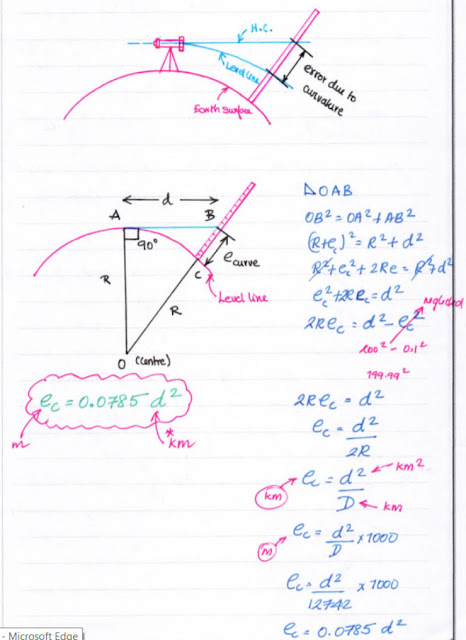Levelling
- Levelling can be defined as the art of determining the relative positions of the points on the ground surface of the earth to compute earthwork. i.e., the volume of soil to be filled or to be excavated.
- Levelling is applied in a vertical plane, where a levelling staff and a dumpy level (telescope) are required.
- The level line is always a curved line parallel to the earth surface.
- The top water surface of a pond at rest condition (still) is nothing but level surface.
- The line of collimation or the line of sight is the line joining the point of intersection of crosshair of the diaphragm to the optical centre of object glass & its continuation. It plays an important role in determining staff readings like Back sight, Intermediate sight & Foresight.
- The axis of the telescope is the line joining the optical centre of the eyepiece & the optical centre of object glass of a telescope.
- The axis of the bubble tube is the tangential line of the bubble which is always horizontal if the bubble is at the central position, which is the basic principle adopted in the dumpy level. i.e., Before starting the levelling work, the bubble must be brought to the central position so that the line of collimation will be truly horizontal, which is obtained by temporary adjustment at every new setup of the telescope instrument. By turning the foot screws inwards or outwards the bubble is brought to the central position.
- The known elevation of the ground surface above Mean sea level ( Bombay Sea Level) is known as Bench Mark. Levelling work must start from the Benchmark. Levelling work must start from the Benchmark to fix the RL of the line of collimation known as Height of Instrument (H.I) or Height of Collimation (H.C). a) GTS ( Great Trigonometrical Survey of India) b) Permanent Bench Mark c) Temporary Bench Mark d) Arbitrary Bench Mark
Back Sight:- (BS)
It is the first staff reading obtained on the levelling staff if the staff is kept on a benchmark. The back sight is always required to find the Reduced Level (RL) of the line of collimation. i.e., the RL of the line of collimation = RL of Benchmark + Back sight.
Since BS is added to the RL of BM to get RL of the line of collimation, BM is also known as Plus sight.
Intermediate Sight:- (IS)
It is the staff reading obtained at different positions (station) to determine the RL of ground stations. i.e., RL of stations = RL of line of collimation - Intermediate sight.ForeSight:- (FS)
It is the last staff reading obtained from one setup of the instrument to determine the RL of change point (turning point). i.e., The RL of change point = RL of the line of collimation - Fore sight.= HC or HI - FS
The foresight is also known as Minus sight. The foresight and backsight are taken at one place called change point.
The Back sight at every change point is required to determine new RL of collimation of second set up of the instrument and hence the RL of change point plays an important role. i.e., RL of a new line of collimation = RL of change point + BS
= RL of the previous line of collimation - Foresight + Backsight
While shifting the instrument, the staff should be in one place only called change point. i.e., Foresight and Back sight is obtained at the change point. The position of the instrument on the ground is NOT the station. i.e., the position of levelling staff is the Station.
Effect Of Curvature And Refraction:-
- Since the level line is a curve line but the line of sight or line of collimation is a horizontal line due to which the staff reading increases (more than the actual ). Therefore an error takes place in the staff reading known as Curvature effect.
- Due to the curvature effect, the error is positive and hence the correction shall be negative.
- Since the ray of light passes through the different density of atmosphere due to which the line of collimation bend down, which is not truly horizontal called refraction effect. Due to the refraction effect, the staff reading decreases and hence the error is negative due to refraction. It means the correction shall be positive.
- The combined error due to curvature and refraction is always positive and hence the combined correction is always negative. Due to the curvature of the earth, the object sighted appears lower than they really are but due to refraction effect, the object sighted appears higher than they really are. Due to combined effect, the objects sighted appear lower than they really are.
- To neutralize ( to take care of ) curvature and refraction effect, 'reciprocal levelling' is adopted.
- To neutralize curvature and refraction effect while determining the difference of RL of two ground station (staff station), the instrument is kept exactly at Midway between two ground station.
- Derivation of curvature and refraction is given below.
 |
| levelling-surveying-civil-engineering |
 |
| levelling-surveying-civil-engineering |
Derivation on Dip of Horizon is given below
 |
| Dip of horizon |



0 Comments